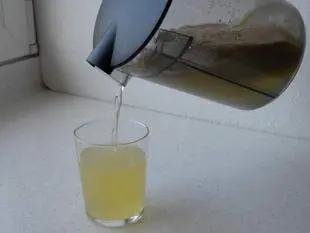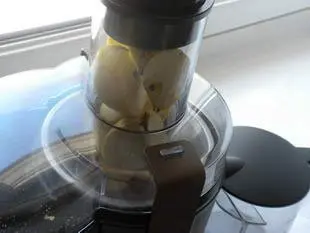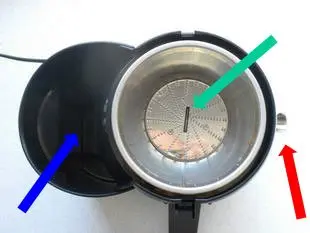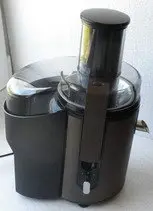To find out more...
How to choose a centrifugal juicer

 The principle is very simple: the chosen fruit is fed into the top of the machine through a pipe called a "chimney".
The principle is very simple: the chosen fruit is fed into the top of the machine through a pipe called a "chimney".
 The fruit is washed, but not peeled as this is not necessary. They are pulverized by a grater which rotates at very high speed (green arrow), the pulp obtained is thrown against a very fine grid where the juice is extracted by centrifugal force (hence the name), the "dry" pulp is ejected at the rear into a collection tray (blue arrow), and the precious juice is collected in a pitcher (red arrow).
The fruit is washed, but not peeled as this is not necessary. They are pulverized by a grater which rotates at very high speed (green arrow), the pulp obtained is thrown against a very fine grid where the juice is extracted by centrifugal force (hence the name), the "dry" pulp is ejected at the rear into a collection tray (blue arrow), and the precious juice is collected in a pitcher (red arrow).
 Note that the resulting juice is very, very frothy, and you'll need to wait a few minutes for it to settle before the froth rises to the top and the (clear) juice settles to the bottom.
Note that the resulting juice is very, very frothy, and you'll need to wait a few minutes for it to settle before the froth rises to the top and the (clear) juice settles to the bottom.
Selection criteria
There are all sorts of centrifuge models and brands to choose from, and having hesitated a great deal before taking the plunge, I'd like to give you the points I consider important, or not, in making your choice.What's important
- Power and speed: these determine the machine's capacity and efficiency. To be efficient, it needs to turn very fast (8,000 rpm minimum), and be powerful (500 watts minimum) to avoid jamming during operation.
- The recovery pitcher: This essential element receives the juice that flows from the centrifuge, and is designed so that when you pour, the foam remains in the pitcher and only the juice flows out.
- The pulp tank or pulp selector: A tank at the back of the centrifuge that receives the pulp from whatever you're juicing, it allows you to juice large quantities of fruit before having to clean the machine.
- The size of the chimney: The larger the chimney, the better, as it allows you to process whole fruits (apples, for example) without cutting them.
Not essential
- Centrifuge parts are dishwasher-safe, but cleaning by hand is easier and more effective.
- The centrifuge's spout can be raised to avoid dripping onto the work surface, which is just handy.
- Several rotation speeds, although we always use the maximum speed.
- Citrus juicer function, but of little interest.
To sum up
- 500 Watts, 800 rpm minimum
- Recovery pitcher
- Pulp bin
My choice
Based on these criteria, I opted for a Philips HR 1858, which I bought for around €150 in 2010. I'm very happy with it, although it broke down after 1 month and was sent to the after-sales service for 3 weeks... But since then, it's been a real pleasure to use: Grany apple juice, for example, made in 1 minute, is simply divine!
But since then, it's been a real pleasure to use: Grany apple juice, for example, made in 1 minute, is simply divine!
Butter vs. grease
We often read in a recipe where a pastry is put into a mould that, just before pouring, the mould should be buttered or greased. But what's the difference between these 2 terms?December 1st 20251,0735
Getting out of the fridge early
Very often when you're cooking, you need to take food or preparations out of the fridge, to use them in the recipe in progress. There's nothing tricky about this: you just take them out of the fridge and use them, usually immediately, in the recipe. But is this really a good method?November 24th 20251,1625
Who's making the croissants?
When you look at a bakery from the outside, you naturally think that in the bakery, the bakers make the bread, and in the laboratory, the pastry chefs make the cakes. It's very often like that, with each of these professions having quite different ways of working, but sometimes there's also one...November 23th 20251,058
Oven height
When we put a dish or cake in the oven, we naturally tend to put it on the middle shelf, and that's what we usually do. But in some cases, this position and height can be a little tricky, so let's find out why.October 8th 20252,8585
The importance of sieving
In recipes that use a fine powder (flour, powdered sugar, etc.), you'll often see the advice to sift before using it. To sift is to pass the powder in question through a sieve (a very fine strainer) before incorporating it into your recipe. It's often advice, but is it really useful?September 3rd 20257,5963
Kitchen ovens
You certainly have one in your kitchen, an oven, the essential tool for all kinds of cooking, whether in the kitchen of course, but also in pastry, bakery, pizza, and many others. Here is some information on its structure and operation.May 16th 202034 K4.4
In praise of slow cooking
You will no doubt have noticed that in cookery, it's often the actual cooking process that gets neglected. This is understandable; it comes at the end of the recipe and getting the dish in the oven is something of a relief (ah, that's done!), which frees us to cope with what's left: tidying the...February 9th 201142 K4.2
Butter doesn't make you fat, unless you eat too much of it.
Whenever I'm discussing cooking and recipes, there is one idea which comes up frequently, like this: "Oh no! But that's got butter in it" (I should add, for the sake of accuracy, that this is something I hear more frequently from women, who are almost all concerned with keeping their figure). ...March 26th 201245 K4.5
Fruits which can ruin your jelly
There are many ways of making a fruit mousse, but one of the simplest is to prepare a fruit jelly (basically a fresh fruit coulis with gelatine) and then mix this jelly before it sets completely with whipped cream. The result is perfect for filling a charlotte, for example. But do beware;...March 6th 201378 K4.0
The window-pane test in bread-making
The home bread-makers often ask themselves “Have I kneaded my dough long enough?” . A good question, as dough that is insufficiently kneaded will not rise properly or will fall flat when the top is slashed, which is very frustrating. To know when the dough is ready, one can rely on the length...June 16th 202197 K 23.9









